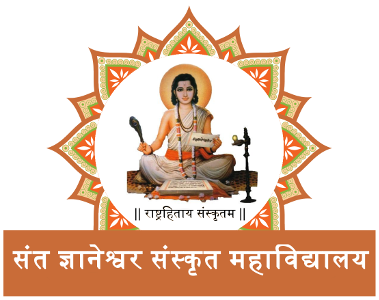Kavikul Guru Kalidas Sanskrit UniversityRamtek-Nagpur Government Educational Institute Attached...
More Information
1) Sanskrit introduction.
Sanskrit is the root language of all Indian languages as well as major foreign languages. In ancient times, Sanskrit was spoken in India. In this language, Vipavangamayam, Ramayana, Mahabharata, various classical texts, poetry, plays, stories etc. were produced in abundant literature. This is a very proud story.
Sanskrit script is Devanagari. Since its Marathi language has the same script, its backlinks also are the same. There are 46 characters in Sanskrit. There are two types of vowels and consonants.
There is a belief that Sanskrit is very difficult and complex. Of course it does not have any facts. Because no language is easy or difficult. So it depends on her attitude to look at her ...
Career in Sanskrit - Grammar Philosophy Proficiency in Sanskrit and Foreign Language Research Opportunities in Sanskrit and Computer Media Opportunities in Government Job Paurohita, Kirtan Shastra, Music, Arts, Harmonium, Tabla, Mridangavadan
2) Paurohita.
In India, Sanatan Vedic religion is believed to be Shruti Smriti-Puranic religion. Therefore, along with the Shruti (Vedas) and Smruti, Puranas are of importance to Vedic religion. All the knowledge needed to attain the goal of life as well as Paramartha are found in ritualistic and interesting manner in the Puranic texts. In the Chhandogya Upanishad, Puranas are mentioned along with four Vedas. Foundations of the 6th century theological book have been found in the Puranas. It gives an idea of how ancient times are old.
There are many types of people in the world. Their languages are different. Everyone talks to each other You try to reach the thoughts of others in your heart. Gestures, gestures, dialects and writings are also used for this. The method of writing of all languages is not the same as the script. Someone's hieroglyphs, somebody's Devanagari, somebody's romance and somebody's wings. Apart from this, the utterance of every language is different, the pronunciation is different. By using small sentences, using the fluctuations in the voice, you can say it to others. The same thing as saying. You can write it as it says.
The three books of Ramayana, Mahabharata and Bhagwat are composed of qualities like Purana, History and Poetry. A whole lot of influences from these three texts have come down from ancient times in India. Ramayana is written by Adikavi Valmiki, a mythological treatise, in which there are twenty-four thousand verses in the seven wings. Mahabharata and Bhagwat were written by the Vyas rishis after re-organization of the Vedas, according to ancient traditions, self-meditation.
3)Kirtan Shastri Yesth
सर्गश्च प्रतिसर्गश्च वंशो मन्वन्तराणि च । वंशानुचरितं चेति पुराणं पञ्चलक्षणम् ॥
This is considered as a sign of the Purana. From that on, the creation of the universe, the history of the tribe of Niranarale, Manvantare and Thor Rajarsi, are found in the Puranas. Based on their support, four-quarters of the Purusharthas of Dharma, Artha, Kama and Moksha have been made in the Puranas.
इतिहासपुराणाभ्यां वेदं समुपबृंहयेत् ।
This term is famous in this regard. According to tradition, the total number of eighteen major myths is considered to be more than forty lakhs. Agnipuraan Vapadmapurana This book is full of information about various topics like Knowledge Base. The three books of Ramayana, Mahabharata and Bhagwat are composed of qualities like Purana, History and Poetry. A whole lot of influences from these three texts have come down from ancient times in India. Ramayana is written by Adikavi Valmiki, a mythological treatise, in which there are twenty-four thousand verses in the seven wings. Mahabharata and Bhagwat were written by the Vyas rishis after re-organization of the Vedas, according to ancient traditions, self-meditation.
4) Kirtan Shastri Yesth - Naradiya and Warkari Sampradaya Saints' work of study.
The total number of myths is very big. The next eighteen are Puranas. Brahma, Padma, Vishnu, Shiva, Bhagwat, Future, Narada, Markandey, Agni, Brahmavyvart, Linga, Varah, Skand, Vaman, Kuram, Fisheries, Eagle and Universe. Apart from this there are eighteen suburbs. It can be assumed that the accounts of the Puranas are related to Shiva, Vishnu and Devdhav of his family. Also, Vedic scholars are required to study Puranas by increasing Vedas knowledge
6) Vedanta Process Prabhupada - Vedanta Essay, Idea Chandrodaya, Punikitana, Vyas Sagar, Sanskrit Sanskritiya Vars
It is well known that Sanskrit language and the classical literature in it are the source of Indian culture. Vedas are the major texts in the world's oldest texts. However, there are many differences during the Vedas period. European punditry C. If the past is believed to be between one to two thousand years old, Indian scholars of old thinking believe that it is anad and apurushya. It is the theme of the Upanishads, to describe the nature and relation of the world, the living and the divine. There are four Mahavakya of 'Upamishad', 'Elephantism', 'Ego Brahmsmi', 'Soham', 'Ayamatma Brahma'. The goal of the Upanishad study is to know and experience their meaning. Dassara Shikoh, son of scholar Shahjahan Dash, translated the Upanishads into Persian by the 17th century. In the 18th century, the European scholar of Acktile Duperon translated Latin from the Persian translation. Thereafter, Upanishads were translated into English, German etc. in many European languages. "The study of the Upanishads received the heart of my heart. This chirashanti will not be able to get rid of the heart till the end of my life. " The German element Showen Hauer's exclamation is famous.
